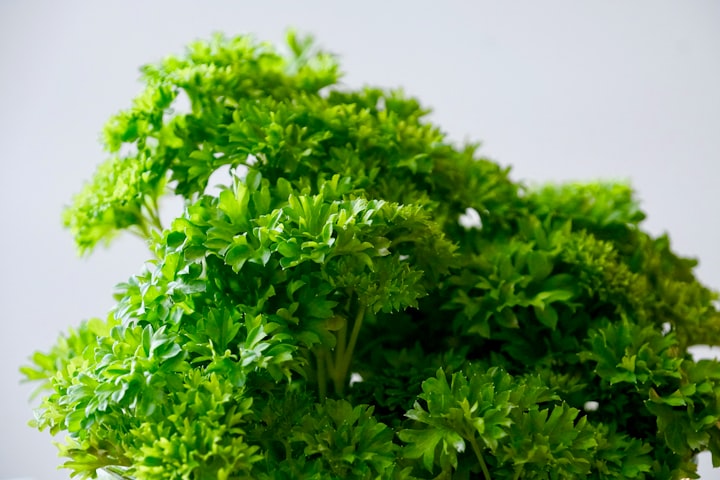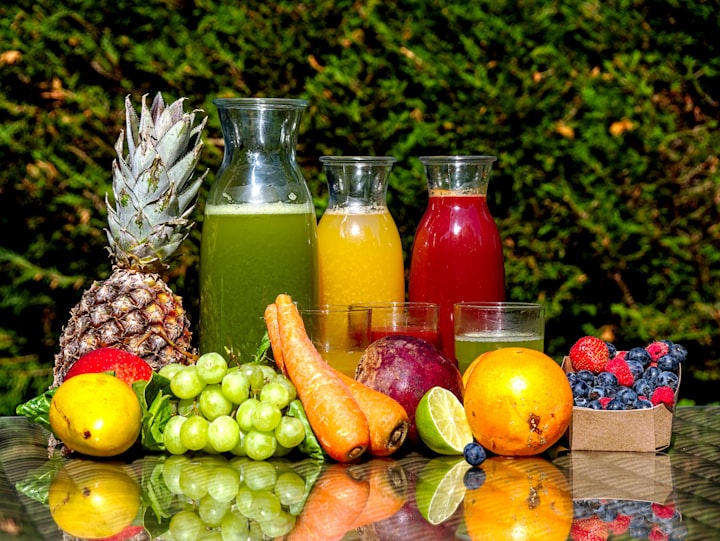Let's Talk About Parsley
Parsley, a Safe Source of Health

Parsley has been prized for its healing properties since antiquity and has been used against epilepsy, kidney disease, and snake and scorpion bites. Today, this plant is attributed to real food, medicinal and spicy qualities.
Physiotherapists claim that parsley is a true collection of vitamins, minerals, and other active ingredients, with remarkable therapeutic properties.
Green leaves are rich in chlorophyll and vitamins C (240 mg per 100 g leaves, 4 times more than oranges), B (vitamin B12 is important in preventing cancer, brain disease, and maintaining pregnancy ) and.
The therapeutic effects of parsley are also related to its content in proteins, enzymes, essential oil, histidine - an amino acid that slows the development of tumors, a dye called apeine, and the high content of mineral salts (Fe, Ca, K, P, Mg, Cu, I). The protein in 100 g of leaves exceeds the content of two eggs.
The therapeutic properties of this plant are evident in all organs (digestive, respiratory, cardiac, reno-genital, and general metabolic):
- stomachic, purifying, antitoxic, anti-infective, antiseptic, deworming;
- general stimulants, nervous and smooth muscle fibers, antiallergic;
- hypotensive and vasodilators;
- antitumor and antioxidant;
- antiasthmatic, diuretic;
- antianemic, antiscorbutic, purifying, antirachitic, tonic, and appetizing.
Forms of use:
- The treatment of fresh leaves (40 g per day) has an effect in combating malignant tumors in the brain, lungs, liver, and kidneys. It cancels the negative reactions of alcoholism and smoking, detoxifies the body, and removes the unpleasant smell of the mouth after drinking wine, tobacco, and garlic;
- fresh leaf salad, mixed with a little olive oil and lemon juice, is consumed in a 2-week cure for tonic and invigorating effects;
- fresh juice from leaves and roots is consumed daily 50-200 ml, diluted with a little water, to combat kidney and gallstones and to invigorate weakened organisms;
- essential oil from seeds (a few drops on sugar) is effective against kidney and biliary pain, intestinal colic, stones, intestinal bloating, and kidney and heart edema in the lower limbs;
- externally, they use poultices from freshly crushed leaves, with antiseptic and healing effects in the healing of wounds, wounds, freckles, bruises, thrombocytopenic purpura, and insect bites.
Natural recipes based on parsley roots
DECOCT from parsley roots: the roots, prepared in the form of a stew (2 teaspoons of grated roots in 250 ml of water), are consumed 2-3 cups a day, in a one-month cure, to remove kidney stones and sand.
HIPPOCRATES SOUP: Parsley roots, mixed with parsnips, celery, carrots, potatoes, tomatoes, onions, and garlic are the raw materials for the preparation of "Hippocrates' Soup".
All these vegetables are boiled for 2-3 hours on low heat, passed through a stainless steel sieve, making a portion of food easily assimilated, recommended for cancer patients (do not use aluminum pots or "pressure cooker").
Parsley, a real collection of vitamins
Parsley is a vegetable plant that is not missing from any garden, being widely consumed as a food, medicinal and spicy species. It can be said that parsley is a real collection of vitamins, minerals, and other active ingredients, with remarkable therapeutic properties.
Green leaves are rich in chlorophyll and vitamins C, B, and A. It should be noted that parsley leaves have vitamin C in the amount of 240 mg per 100 g of leaves, 4 times more than in oranges. Vitamin B12 is very important in preventing cancer, brain disease, fertility, and maintaining pregnancy.
Specific therapeutic actions
In the digestive tract, parsley has favorable effects in hepatic steatosis, chronic hepatitis, gallbladder atony, excessive alcohol intoxication, tobacco and coffee, removal of unpleasant odors of the mouth, intestinal parasites, lack of appetite.
In renal-genital diseases it acts by fighting kidney stones, kidney edema, stimulating the elimination of urine, urea, and uric acid, healing painful menstruation, premenstrual syndrome, menstrual cycle regulation, and healing of prostate adenoma.
It intervenes in the nervous system in case of mental depression, nervousness, excessive irritability, asthenia, neuralgia, convalescence.
At the level of the respiratory system, parsley has favorable effects in tuberculosis, chest pain, asthma, fever, dropsy, stimulation of expectoration, and elimination of harmful substances from the lungs and bronchi.
In the development of general metabolic processes, the role of parsley (leaves, roots, seeds) in enhancing the activity of the immune system and the body's resistance to infections, destruction of free radicals involved in cancer, blood circulation disorders, cancellation of growth disorders in children, rickets, chronic anemia.
Very important are the effects in the fight against cancerous tumors, ischemic heart disease and arthritis, rheumatism, and gout (by limiting the inflammatory processes).
In external treatments, parsley is effective in combating dermal diseases (wounds, freckles, contusions, insect bites) and in beautifying hair color.
Careful! Excessive consumption can trigger some digestive disorders and nervous excitations, especially in pregnant or lactating women, as it would stimulate uterine contractions leading to possible abortion or decrease lactic secretion.
Therefore, rational consumption is limited to 200 ml of juice for adults and 60 ml for children, possibly mixed with other vegetable juices or diluted with a little water.
The leaf cure helps to tone the body
Fresh leaves are used to decorate salads and festive meals. Chewing leaves before meals stimulates appetite, prevents nausea and vomiting. A cure of fresh leaves (40 g per day) has an effect in combating malignant tumors in the brain, lungs, liver, and kidneys, cancels the negative reactions of alcoholism and smoking, detoxifies the body, and removes the unpleasant smell of the mouth after drinking wine, tobacco, and garlic.
Fresh leaf salad, mixed with a little olive oil and lemon juice, is consumed in a two-week cure for tonic and invigorating effects.
The decoction of 50 g of parsley leaves, with orange peel and grapefruit, is boiled in a liter of water until the volume is reduced by half, it is sweetened and consumed in the morning, on an empty stomach, against drunkenness.
Fresh juice from leaves and roots is consumed daily 50-200 ml, diluted with a little water, to combat kidney and gallstones, irregular and painful menstruation, and invigorating weakened bodies.
Decoction of roots, effective in eliminating kidney stones
The roots, prepared in the form of a stew (decoction of two teaspoons of grated roots in 250 ml of water), are consumed 2-3 cups a day, in a month-long cure, to remove stones and sand from the kidneys and bile, fight edema and obesity by eliminating excess fluid and toxins from the body, improving digestion and stimulating hair growth.
Parsley roots, mixed with parsley, celery, carrots, potatoes, tomatoes, onions, and garlic are the raw materials for the preparation of "Hippocrates' soup", boil for 2-3 hours on low heat, pass through a stainless steel sieve, making a portion of food easily assimilable, recommended for cancer patients (aluminum vessels and “pressure cooker” are not used).
Parsley seeds, effective for kidney pain
The seeds are used as an infusion (1-2 teaspoons per 250 ml of boiling water), for the diuretic effect and to combat bloating.
The essential oil from the seeds (a few drops of sugar) is effective against menstrual, kidney, and biliary pain, intestinal colic, lithiasis, bloating, and kidney and heart edema in the lower limbs.
Fresh parsley should not be missing from the diet of people with gallstones
What diet should gallbladder patients follow?
On days with painful seizures, a cure with natural vegetable juices (carrot, celery, beetroot), unfermented fruit juices (apples, plums, grapes, oranges, lemons, strawberries, strawberries, gooseberries, blueberries), consumed immediately after preparation, as well as medicinal teas sweetened with honey.
After the end of the crisis, dairy products (sweet milk, yogurt, fresh cottage cheese, sweet cheese, salted cheese, cream) are introduced into the diet.
Vegetable soups (with potatoes, carrots, cabbage, parsley), scraps of egg and flour, boiled greens, vegetable salads (lettuce, spinach, parsley, bell peppers, tomatoes, cabbage), fish are easily supported. lean (trout, pike, flax, Lebanon, pikeperch, cod), lean beef or skinless bird brisket, egg white omelet.
An additional fresh fruit (apples, cherries, strawberries, raspberries) is indicated in the current diet.
Taken in cures for 7-10 consecutive days or fruit juices (apples, lemons). The patient will chew food well, thus reducing the effort of digesting food and the secretory activity of the liver.
Among the vegetables, it is good not to miss the fresh parsley, eaten in the morning, on an empty stomach, and at every meal. Tomatoes served in salads or juices, black radishes and crushed watermelon seeds (1-2 tablespoons per day) are also effective.
Toast is served with bread, polenta, rice, or pudding.
Fatty meat, animal fats, sausages, smoked meats, preserves, excess salt, coffee, cocoa, chocolate, ice cream, strong alcoholic beverages, and some soft drinks (coca-cola, Pepsi-cola) are prohibited.





Comments
There are no comments for this story
Be the first to respond and start the conversation.